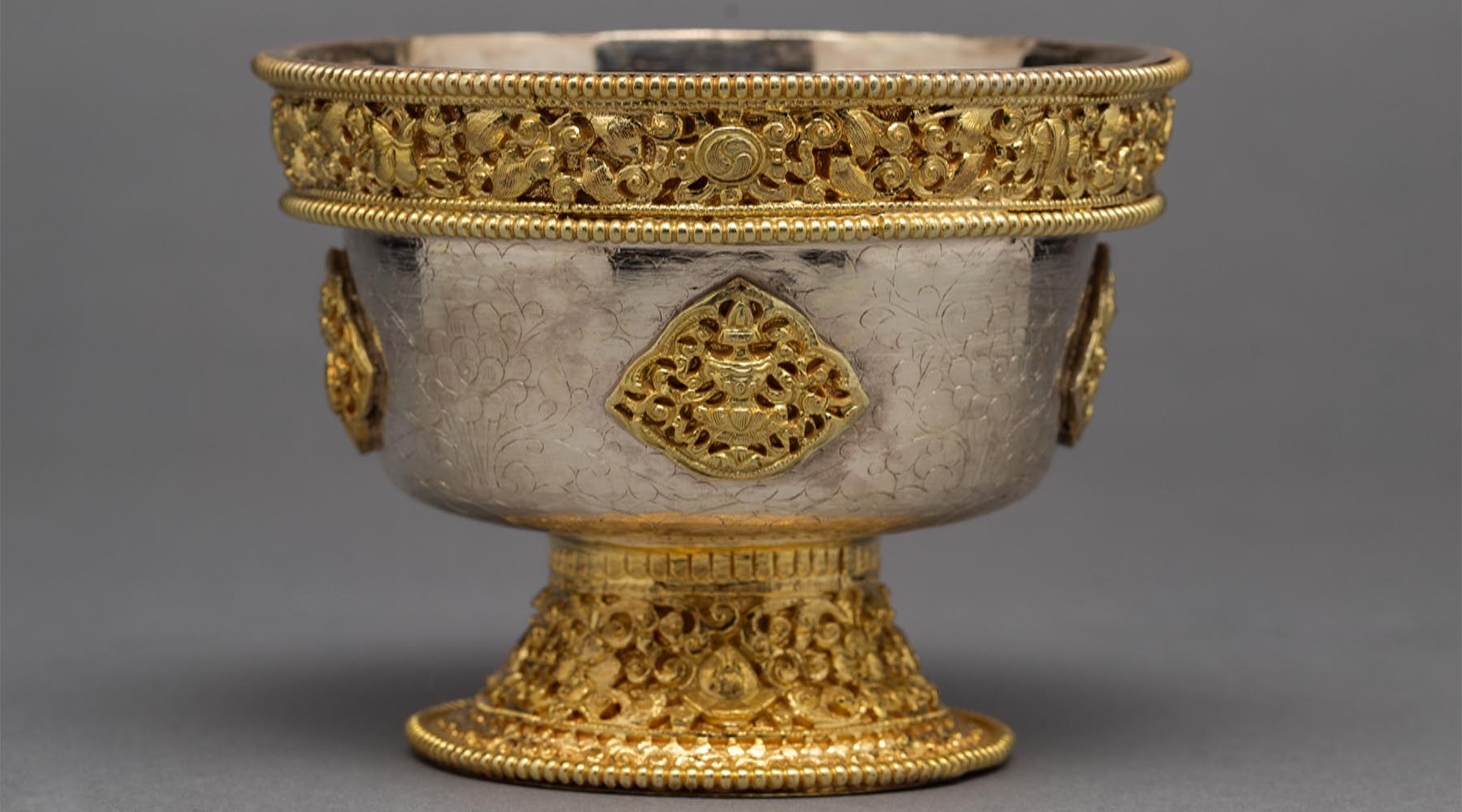Significance of The Seven Water Bowl Offering
There are plenty of ways to show gratitude and devotion both in shrine rooms and during the sacred practice. Placing different gifts is one of nature to accomplish this. In Tibetan tradition, the offering of the seven or eight bowls (Tib: Ting) of water is a common practice by most practitioners.
The making of offering is a practice that helps eliminate clinging and miserliness while also building up good potential. The orthodoxy in Buddhist culture is making the seven-water bowl offering on an altar each day. It is kept in front of and a little below the representations of the Three Jewels. Brass, bronze, or silver is used in the making of the bowls. They have a diameter of about three or four inches. Auspicious designs in repoussé gold or silver inlay often ornament these bowls.
What the Bowls Represent?
The seven bowls represent the 'seven-limbed practice' for purifying negative tendencies and accumulating merit is what seven bowls represent. It includes prostrations; making offerings; confession of non-virtuous actions; rejoicing in the positive actions of oneself and others. As well as requesting the Buddhas to teach; requesting the Buddhas to remain in this world and the dedication of merit.
A Walk through the Ritual
The room where you are making an offering must be clean. Every corner must be thoroughly dusted off, including the altar. The feeling is unparalleled, giving the Buddhas one's undivided attention and presenting a clear mind while cleaning. Source: Evamratna
Source: Evamratna
As a preliminary offering, a little water is poured into each of the cleansed bowls before placing them on the altar. The bowls cannot be offered empty. The left hand is supposed to hold the clean stacked bowls before placement. They are consecrated by reciting the three syllables Om A Hum. Then, one ought to partially fill the top bowl with water. Before it is placed on the altar, most of the water from the top bowl is poured into the second bowl. One repeats the process till all seven bowls form a straight line from left to right.
It is quite common for practitioners to recite mantras such as,
Om muni muni maha munaye soha (Buddha Shakyamuni’s mantra)
Om mani padme hung (Avalokiteshvara’s mantra)
Om tare tuttare ture soha (Tara’s mantra)
The thickness of a barley grain equates to the approximate distance that is supposed to exist between each bowl. Their touching each other means for one to be mentally dull. But if they are too far apart, it means for one to be separated from one’s master. Pure and clean water is used to fill the bowls. It is to be poured 'like a barley grain' from the water vessel's spout. The stream of water should be thin at the beginning, thick in the middle, and narrow stream at the end. Though, it is believed that overflowing the rim's top results in ethical detriment. Also, a low level of water causes a decline in prosperity. Breathing on the water causes defilement, so it is prohibited.
What Each Bowl Contains?
The 'seven offerings' can also be formed by the arrangement of the seven bowls. The seven offerings are presented to the deities. It is done in the same manner in which an honored guest would have been welcomed in one's house in ancient India. There is pure water for drinking and rinsing the mouth in the first bowl. Water for washing the feet is in the second bowl. It is the traditional Indian custom of entering the threshold of a house barefooted.
The third bowl contains fresh flowers. It represents the custom of presenting a male guest with a flower garland. And the female guest receives flowers for her hair adornment. Incense is held by the fourth bowl to please the sense of smell. There is an oil or butter lamp in the fifth bowl. It represents the illumination of wisdom. There is rosewater or perfumed water in the sixth bowl to refresh the face and breast. Finally, there is food in the seventh bowl for the honored guests.
First bowl: Fresh drinking water (Argham) after a long journey and to rinse the mouth,
Second bowl: Water to bathe (Padyam) one's feet as a sign of respect and service,
Third bowl: Flowers (Pushpa) to honor the guest representing vibrant beauty for eyes pleasing,
Fourth bowl: Aromatic incense (Dhupe) to enrich the environment, welcome guests, and please their sense of smell,
Fifth bowl: Holds oil or butter lamp (Aloke) that signifies illumination of wisdom, eradicating all ignorance and mental obscurity.
Sixth bowl: Filled with rosewater or perfumed (Ghande) water,
Seventh bowl: Food (Naividya) to honor guests of every type and richness.
Other Offerings for the Senses
A red or white conical sacrificial cake made from roasted barley flour, dyes, and butter is the usual Tibetan food offering. There is the eighth offering of music is on the list. It is represented by a lute, flute, cymbals, a conch, or a damaru. However, the music offering is more so visualized than actually represented with the seven-offering bowls. The first two water bowls may be combined into one bowl in certain tantric practices or sadhanas. And a damaru or small conch is placed in the seventh bowl that represents the offering of music.
The prescription of all the eight bowls means the formation of correspondence with the eight-offering goddess. The four intercardinal goddesses of flowers, incense, light, and perfume (the third to sixth bowls). And the four cardinal goddesses of beauty, garlands, song, and dance (the pairs of bowls at each end).
Post-Ritual Steps
After arranging the offerings, they are consecrated by dipping a stem of kusha grass into the water vessel and sprinkling the offerings. The syllables Om A Hum are recited three or seven times. The offerings are removed at the end of the day. The water from the bowls is gathered and dispersed with the offerings into the natural environment. It is for the benefit of passing animals or hungry spirits. The bowls are then wiped clean. They are yet again stacked upside down, ready for the next day. Another practice of water offering is performed in the water-puja ritual.
Why do Practitioners make an offering?
Water is seen to be abundant, accessible, and pleasant to offer. The lesson is that we ought to present all of our sacrifices in the same manner as we would provide water. It is believed that our ethics will be pure, just like the water we offer. The lightness of the water signifies one's state of mind, and the clear water means clearness. Practitioners make offering to Lord Buddha with mere respect and devotion.
The process of filling the bowls can have compelling meaning. One can make the process as bestowing all the sentient beings with blissful wisdom nectar. It is always customary for Buddhists to place presents of flowers, incense, and lights on the shrine, whether or not they make a water offering. The incense symbolizes the lovely scent of Shila (discipline), the flowers are the joy and beauty of samadhi (concentration or meditative absorption), and the lights are prajna (wisdom).
Offering for the Nagas and Wealth Deities
A water offering set is used to appease the Nagas and certain wealth deities. This set consists of four metal implements. A small shallow pouring vessel with a spout, and a wide containing bowl. As well as a small tripod that rests within the containing bowl, and a smaller flat bowl that rests on the tripod. The small bowl is repeatedly poured ritual water above the tripod. It is then emptied into the lower containing bowl.
Conclusion
The offering of a water bowl has been practiced for centuries. It has been part of Himalayan Buddhist tradition since the 8th century. But it was widely revered since the 11th century after the arrival of great Indian master Atisha Dipamkarashrijana in Tibet. . He observed how clean the rivers and springs in Tibet were. Thus, he said that a simple water donation would suffice in the Himalayas. That made yonchap even more typical.




